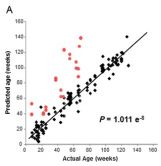
2012/12/05
A metabolic signature predicts the biological age in mice
It is the metabolism, not the genes or the proteins, what defines better the phenotype of an organism. Consequently, the study of the unique metabolic signature that specific cellular processes leave behind is the most promising approach to determine phenotypic changes associated with health and disease. To test this hypothesis, investigators of the Spanish National Cancer Research Center (CNIO) and of the Center for Cooperative Research in Biosciences (CIC bioGUNE) have analyzed the serum metabolome during aging in mice. This has allowed the identification of a metabolic signature that reliably and accurately predicts the age of mice. In the case of telomerase-deficient mice, which have a shortened lifespan, their metabolic fingerprint predicts older ages than expected. Conversely, in the case of mice that over-express telomerase, their metabolic signature corresponded to younger ages than expected. Importantly, telomerase reactivation late in life by using a telomerase based gene therapy significantly reverted the metabolic profile of old mice to that of younger mice. These results indicate that the metabolic fingerprint is associated to the biological age rather than to the chronological age. This constitutes one of the first aging-associated metabolic studies in a mammalian organism.
Figure. Age predictions with respect to the wild-type mice metabolic signature. The wild-type mice metabolic ageing signature (black diamonds) fits a linear model: Predicted Age = 0.934·Actual Age + 3.971 (r2=0.944). The short-lived telomerase-deficient mice showed a significantly older metabolic age when compared to wild-type mice of the same chronological age (red circles).
See a large version of the first picture





